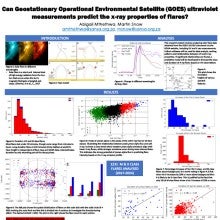Can Geostationary Operational Environmental Satellite (GOES) ultraviolet measurements predict the X-ray properties of flares?
Abigail
Mthethwa
South African National Space Agency
Poster
Solar flares are powerful phenomena with significant implications for space weather. Understanding their characteristics and predicting their behaviour is crucial for mitigating potential risks and ensuring the safety of space-based operations. This research project aims to investigate whether ultraviolet (UV)
measurements obtained from the Geostationary Operational Environmental Satellite (GOES) can be used to predict the X-ray properties of solar flares. By analysing high-cadence UV solar spectral irradiance data from the GOES Extreme Ultraviolet and X-ray Sensors (EXIS) instrument, the study seeks to establish a reliable relationship between UV observations and X-ray flare behaviour. The ultimate
goal is to develop a model that enables real-time prediction and interpretation of solar flares, empowering space weather forecasters to make accurate forecasts and take necessary precautions.
measurements obtained from the Geostationary Operational Environmental Satellite (GOES) can be used to predict the X-ray properties of solar flares. By analysing high-cadence UV solar spectral irradiance data from the GOES Extreme Ultraviolet and X-ray Sensors (EXIS) instrument, the study seeks to establish a reliable relationship between UV observations and X-ray flare behaviour. The ultimate
goal is to develop a model that enables real-time prediction and interpretation of solar flares, empowering space weather forecasters to make accurate forecasts and take necessary precautions.

Poster PDF
Poster category
Space Weather Policy and General Space Weather Contributions
Meeting homepage